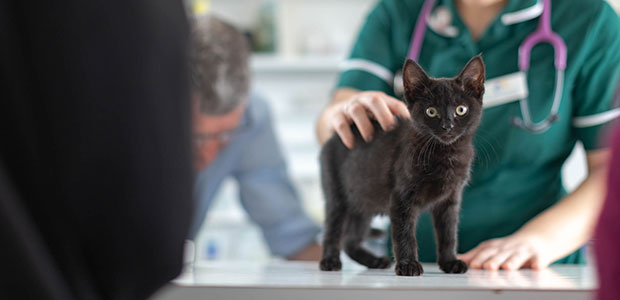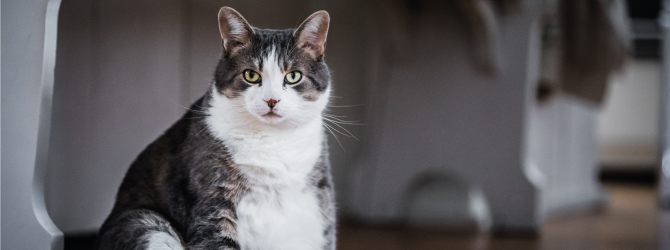How much should a cat weigh? What's the average cat weight?
First Published: 03/01/2019
Last Updated: 14/01/2025
It’s often tempting to give our cats extra food and treats, and because we see them every day it’s difficult to notice changes in their weight.
Let’s take a look at how to spot if your cat is overweight or underweight.
Brief summary...
- 4-4.5kg is a good ‘ideal cat weight', but this varies depending on the breed
- Obesity can increase your cat’s risk of diabetes, arthritis and other health problems
- Can you feel your cat’s ribs easily? They may be overweight if not
- Are their spine and shoulder bones easy to make out?
- A suitable diet will help your cat to lose weight – ask your vet for advice
- Exercise & enrichment games will also help control their weight
Read more: What fruit can cats eat?
How much should a cat weigh?
It varies depending on the breed but for most domestic cats, you can take 8-10 pounds (3.6-4.5 kg) as an ideal weight. Certain larger breeds can weigh as much as 25 pounds (11 kg) and smaller breeds can weigh as little as 5 pounds (2.2 kg) but the average weight table below provides a good guide for the most popular breeds. Remember, Pet Health Club members get a six-monthly healthy pet check from their vet or vet nurse every six months. You can ask about your cat's weight then.
Cat weight chart
| Cat Breed | Female Weight | Male Weight |
|---|---|---|
| Domestic |
8-10lb / 3.6-4.5kg |
8-10 lb / 3.6-4.5kg |
| Himalayan | 7-12lb / 3.2-5.4kg | 7-12 lb / 3.2-5.4kg |
| Maine Coone | 10-15lb / 4.5-5.8kg | 15-25lb / 6.8-11.3kg |
| Persian | 7-12lb / 3.2-5.4kg | 7-12lb / 3.2-5.4kg |
| Siamese | 7-10lb / 3.2-4.5kg | 7-10lb / 3.2-4.5kg |
Read more: Cat diet advice: what’s the best food to give my kitten or cat?
Why is maintaining a healthy weight for a cat so important?
Obesity causes health problems in cats, similar to humans. Overweight cats can be at risk of diabetes, pancreatitis (a painful condition caused by a high-fat diet), arthritis and joint problems, feline skin cancer and skin sores. By keeping an eye on your cat’s weight, you will lower their risks of these problems and keep them a lot healthier.
There are tests you can do on your own to determine whether your cat is at an ideal weight. Firstly, do they look underweight or overweight? Does their belly sag in any way or are they visibly different in appearance to other cats? If this is hard to spot because you see your cat every day, ask your friends or family to see if they can notice a difference.
Other tests can include:
- When you run your fingertips along your cat’s side, can you feel their ribs?
- Is their spine noticeable?
- Can you feel their shoulder bones?
- Based on our cat body shape chart, how does your cat’s appearance compare?
If your answer to these questions is yes, your cat is likely at a healthy weight. If the ribs, spine and shoulder bones are overly visible however, there is a chance your cat is underweight.
If you struggle to feel your cat’s bones or can detect a layer of fat above them, your cat may be overweight.
Cat body shape chart
In this body condition score chart you can see that a body score of 4-5 is ideal. This demonstrates that your cat is a healthy weight as you can feel their ribs, spine and hip bones while their waist and abdominal tuck are visible from above.

Read more: Cat vaccinations: keeping your kitten healthy and happy
How do I get an obese or overweight cat down to a healthy cat weight?
Cut down on treats and avoid feeding them human foods altogether. Make sure your cat is on the correct diet for their life stage. If appropriate, a neutered or senior cat diet will provide better calorie control. If your cat is obese, speak to your vet or registered veterinary nurse about weight loss diets: these provide all the required proteins, vitamins and minerals while reducing calories. Remember, when changing any diet, introduce the new food gradually over the course of about a week.

Exercise and enrichment are important too
Puzzle feeders can also be a great help. Making your cat work for their food rather than simply presenting it to them is more representative of the life they’d lead in the wild, and will keep their minds occupied too, as well as helping them to burn calories.
Read more: 5 enrichment ideas for cats!
Try some good old-fashioned exercise! Increased activity, which you can bring about by playing games with your cat, will help your cat burn calories and will strengthen the bond between pet and owner too. Cats like to play before eating because this mimics natural hunting behaviours.
Need more advice?
Before making any big decisions about your cat’s weight and how to act, it’s a good idea to take them to see the vet or registered vet nurse. They will be able to conduct a proper weight check and to give advice on diet and exercise that is tailored to your specific cat.
Find your nearest vet using our Find a Vet page, or speak to a vet online using our online vets service.



